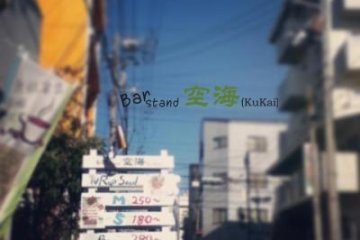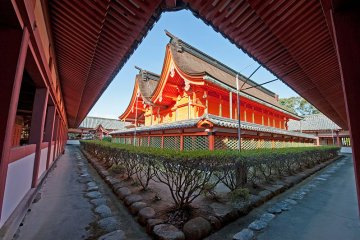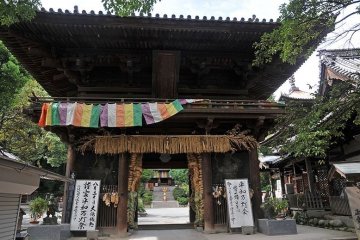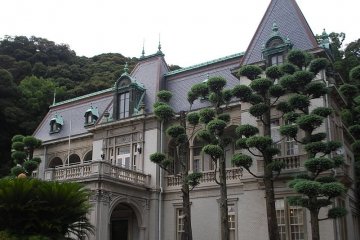
Bar Stand 「空海(KuKai)」
Kazumi Shigematsu【Bar stand 「空海(KuKai)」】是位于爱媛县松山市的城北,爱媛大学和松山大学的城北校园附近的店。我们最强力推荐的是的Wrap sandwich(卷饼),一般标准大小是S寸180日元一个,有一只手大哦;双手大小M寸也只要250日元起~

Dogo Onsen, in central Matsuyama, is one of Japan's oldest hot springs with the main honkan one of the most famous locations at its very center. This wooden public bathhouse dates back to 1894 (Meiji Period) and is said to be one of the inspirations behind film director Hayao Miyazaki's acclaimed Spirited Away anime.
The iconic, 130-year-old main bathhouse at Dogo Onsen reopened fully in July 2024 after a 5.5 year hiatus from renovation and repair work.

【Bar stand 「空海(KuKai)」】是位于爱媛县松山市的城北,爱媛大学和松山大学的城北校园附近的店。我们最强力推荐的是的Wrap sandwich(卷饼),一般标准大小是S寸180日元一个,有一只手大哦;双手大小M寸也只要250日元起~

Thought to be at least 1,000 years old, Isaniwa is one of Japan’s three shrines dedicated to the deity Hachiman. After climbing a long stretch of stone stairs, passing a double-story gate, a magnificent bright-red structure emerges. The architectural details are especially grand with the building’s swooping tile roofs, gold-leaf columns and ornate, cloudlike beam engravings. In addition to the spectacular architecture, there are displayed paintings of warriors and warfare (as Hachiman is the guardian of warriors and protector of Japan) and even numerous documents on Japanese mathematics. A hall of treasures features swords and armor for samurai history buffs. Other relics include animal paintings and calligraphy. Supposedly, Isaniwa Shrine originally marked the location where Emperor Chuai and Empress Jingu, who reigned in the third century AD, bathed at one of Japan’s oldest bathhouses, Dogo Onsen, now just a few hundred meters away. The shrine was moved to by the Kono samurai clan in the fourteenth century to the current location where, after conquering the stairs, you can enjoy breathtaking views of Matsuyama city. It was rebuilt in the 17th century by the Matsudaira clan; the current buildings with their great vermilion surface date from 1667. The original imperial bathers are enshrined there. Despite its age, the shrine is still buzzing with worshippers and even couples celebrating or taking pictures for their wedding. Although visitors note that the stairs are a little treacherous, the views and tranquil atmosphere only add to the experience of walking around the colonnade and absorbing a rich and long history—and if you’re lucky, observing a modern-day ceremony. If the trip does tire you out, you can always relax at Dogo Onsen at the foot of the compound.

At Matsuyama’s most famous temple, a sight almost as guaranteed as the temple buildings themselves is the cadre of pilgrims in white traveling the Shikoku Pilgrimage, a circular 88-site, 1200-kilometer circuit. Whether you’re at Ishiteji for religious, ascetic or sightseeing reasons, the compound is sprawling and quite unusual. On both sides of Niomon Gate (a National Treasure) are two monumental straw sandals, promising relief for those suffering with painful leg conditions. As you reach the main area, you’ll be greeted by even more curiosities. Stroll through the main hall, itself lined with vibrant panel paintings, enter a cave and you reach yet another temple. This inner structure resembles a large golden bead and contains a famously eclectic collection of sculptures, carvings and paintings. Particularly arresting are the images of the skeletal historic Buddha in the period before his enlightenment. Accompanying these are countless Kannon figures, dwarves, demons and deities. Kobo Daishi, a famous Buddhist monk who supposedly originated the Shikoku Pilgrimage, is immortalized in a towering statue on a nearby forested hill. On top of its treasure-packed halls, a three-story pagoda occupies the main grounds. Ishiteji, which literally means “stone hand temple,” has an origin story as unique as its contents. A man had wronged Kobo Daishi and, wanting to atone, established the path of the Shikoku Pilgrimage in search of the monk. When they finally met, Kobo forgave him and gave him an inscribed stone with which he was buried. Then a boy was born with a stone clenched in his hand; this boy came to build Ishiteji. The legendary stone is still in a small museum on the compound, surrounded by no shortage of similarly precious relics, treasured buildings and, supposedly, people’s souls. If Ishiteji Temple proves to be sensory overload or a tiring trek, historic Dogo Onsen is a few minutes away.

Most might not expect to find a French-style villa below Matsuyama Castle, but this elegant construction offers a respite from the bustling town center of Ehime. Bansuiso, largely hidden by trees and modern buildings, was originally the second Residence of Count Hisamatsu Sadakoto, a descendant of the Matsuyama samurai clan and former lord of the neighboring castle. After living in France and returning with his love of Neo-Renaissance architecture, he commissioned the construction of the villa. Completed in 1922, it was the scene of numerous elite parties and social gatherings, and even welcomed members of the imperial family as guests, including Showa Emperor Hirohito. Bansuiso serves as both a place of art and culture and a sight. The first floor and the basement are freely accessible and for ¥ 300 visitors can climb a wooden staircase to take advantage of more photo opportunities. Although the villa hosts solo exhibitions, it also has its own murals and portraits, including the portrait of the first owner.